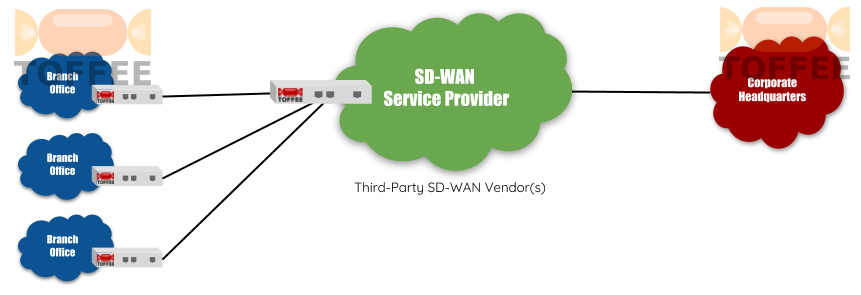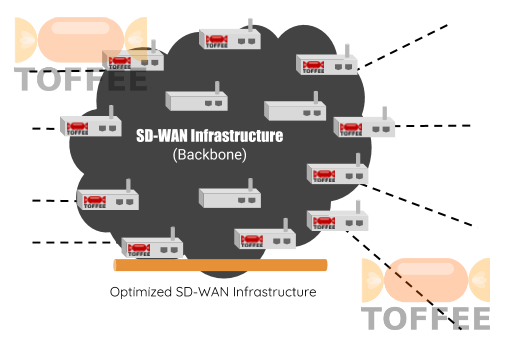DOCUMENTATION 》 TOFFEE (and TOFFEE-DataCenter) deployment in SD-WAN Applications
Software-Defined Wide Area Networking (SD-WAN) is a new innovative way to provide optimal application performance by redefining branch office networking. Unlike traditional expensive private WAN connection technologies such as MPLS, etc., SD-WAN delivers increased network performance and cost reduction. SD-WAN solution decouple network software services from the underlying hardware via software abstraction.
Last Mile Connectivity challenge:
If you are a SD-WAN provider you may have an efficient SDN-Cloud based SD-WAN infrastructure, but the real challenge is the
connectivity between your clients (SD-WAN subscribers/users Branch Office Edge Devices/CPE) and your Cloud Infrastructure.
This last mile connectivity bottleneck can be addressed via TOFFEE-DataCenter as shown below.

NOTE: In this case let us assume you (the SD-WAN service provider) have a client/subscriber who got high-speed network connectivity between their corporate headquarters(may be situated in a data-center, etc) and your SD-WAN Cloud Infrastructure. But they have various other remote branch-offices with extremely poor high-latency Internet/network connectivity.
SD-WAN Infrastructure using TOFFEE-DataCenter as one of its building components:
Along with VPN modules/components you can even use TOFFEE-DataCenter as one of the building blocks within your SD-WAN Infrastructure.

Temas sugeridos:
TOFFEE-DataCenter - Optimización WAN
Categories
| 💎 TOFFEE-MOCHA new bootable ISO: | Download |
| 💎 TOFFEE Data-Center Big picture and Overview: | Download PDF |
Saturday' 13-Mar-2021

Saturday' 13-Mar-2021

Saturday' 13-Mar-2021
Featured Educational Video:
Research :: Optimization of network data (WAN Optimization) at various levels:

Learn Linux Systems Software and Kernel Programming:
![Linux, Kernel, Networking and Systems-Software online classes [CDN] Linux, Kernel, Networking and Systems-Software online classes [CDN]](http://sareesaremypassion.org/cdn/the-toffee-project/i/the_linux_channel_banner2.jpg)
Hardware Compression and Decompression Accelerator Cards:

TOFFEE-DataCenter on a Dell Server - Intel Xeon E5645 CPU:








